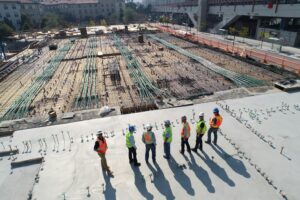Building a Net-Zero Home: What You Need to Know
Understanding the Concept of a Net-Zero Home
This section will introduce the basic principles of a net-zero home, explaining its significance in sustainable living, highlighting the energy efficiency and self-sufficiency aspects.
The Importance of Energy Efficiency in Net-Zero Homes
Energy efficiency is the cornerstone of a net-zero home, ensuring that the energy consumption is balanced with the energy production. By optimizing insulation, utilizing energy-efficient appliances, and implementing smart home technology, homeowners can significantly reduce their carbon footprint and enhance the sustainability of their living environment.
The Role of Renewable Energy in Achieving Net-Zero
Renewable energy sources, such as solar panels and wind turbines, play a critical role in achieving a net-zero home. These technologies not only reduce dependence on non-renewable energy sources but also help homeowners generate their own power. Integrating renewable energy into the home’s design ensures energy independence and long-term environmental benefits.
Understanding Self-Sufficiency in a Net-Zero Home
Self-sufficiency in a net-zero home implies that the home can produce at least as much energy as it consumes. This balance is achieved through a combination of energy-saving strategies and the use of renewable energy systems. By fostering self-sufficiency, homeowners can enjoy greater energy security and contribute to a more sustainable future.
Designing a Net-Zero Home: Essential Considerations
This section will cover the key factors to consider when designing a net-zero home in the USA, including site selection, architectural design, choice of materials, and integration of renewable energy sources to ensure maximum efficiency and sustainability.
Site Selection and Its Impact on Net-Zero Home Design
Choosing the right site is a crucial step in designing a net-zero home. Factors such as orientation, shading, and local climate can significantly influence energy efficiency. By selecting a location that maximizes natural light and minimizes exposure to harsh weather conditions, homeowners can reduce energy demands and optimize the effectiveness of renewable energy systems.
The Role of Architectural Design in Net-Zero Homes
Architectural design plays a vital role in the functionality and sustainability of a net-zero home. By incorporating energy-efficient layouts, passive solar design principles, and high-performance windows, architects can minimize energy consumption and enhance comfort. Thoughtful design choices, such as open floor plans and strategic placement of windows, contribute to a balanced and efficient energy flow within the home.
Integrating Renewable Energy in the Design Phase
Integrating renewable energy sources during the design phase is essential for achieving a net-zero home. Careful planning for solar panel placement, wind energy accessibility, and geothermal installations can ensure a seamless integration with the home’s architecture. This proactive approach not only supports energy independence but also maximizes the benefits of renewable technologies right from the start.
Building Materials and Technologies for a Net-Zero Home
This section will discuss the latest building materials and technologies that enhance the efficiency of a net-zero home. It will cover insulation options, innovative construction methods, and smart home technologies that contribute to achieving net-zero energy goals in the USA.
Innovative Insulation Options for Net-Zero Homes
In a net-zero home, insulation is key to maintaining optimal energy efficiency. Utilizing materials such as spray foam, rigid foam boards, and advanced fiberglass can significantly enhance the thermal envelope of the house. These cutting-edge options help to minimize heat loss during winter and keep the home cool during summer, reducing overall energy consumption and reliance on heating and cooling systems.
Advanced Construction Techniques for Net-Zero Energy Efficiency
Employing advanced construction techniques is vital for achieving a net-zero home. Methods like airtight construction, prefabrication, and passive house principles ensure the building structure maximizes energy efficiency. By minimizing air leakage and thermal bridging, these strategies contribute to the home’s ability to meet its energy needs sustainably and cost-effectively.
Smart Home Technologies to Enhance Net-Zero Living
Incorporating smart home technologies in a net-zero home is a game-changer for energy management. These technologies include smart thermostats, automated lighting systems, and energy-efficient appliances that can be programmed to operate at optimal times. By providing real-time energy usage data and enabling remote control, smart systems empower homeowners to optimize their energy consumption, further supporting net-zero home goals.
Financial Considerations and Incentives for Building a Net-Zero Home
This section will explore the financial aspects involved in creating a net-zero home, including initial investment costs, potential savings on energy bills, and available incentives and rebates in the USA that can support homeowners in achieving net-zero energy status.
Initial Investment Costs for a Net-Zero Home
Understanding the upfront costs is crucial when planning to build a net-zero home. These costs often include expenses for high-efficiency appliances, solar panel installations, and advanced building materials. Although the initial investment can be substantial, it is important to consider the long-term financial benefits, such as reduced energy bills and increased property value, which can outweigh these initial expenses and make the investment worthwhile.
Potential Savings on Energy Bills with Net-Zero Homes
One of the significant financial benefits of a net-zero home is the potential savings on energy bills. By producing as much energy as the home consumes, homeowners can significantly reduce or even eliminate their electricity costs. These savings not only help recoup the initial investment over time but also offer a reliable hedge against rising energy prices, providing a stable and predictable expense line in the household budget.
Incentives and Rebates Available for Net-Zero Homes
In the USA, numerous incentives and rebates are available to encourage the construction and adoption of net-zero homes. These can include federal tax credits, state-specific programs, and utility company rebates for energy-efficient upgrades. Taking advantage of these incentives can significantly reduce the financial burden of building a net-zero home, making the transition to sustainable living more accessible and affordable for homeowners.
Conclusion: Embracing the Future with Net-Zero Homes
Building a net-zero home in the USA is a forward-thinking approach that aligns with the growing emphasis on sustainable living and environmental responsibility. By understanding the importance of energy efficiency, integrating renewable energy sources, and leveraging innovative materials and technologies, homeowners can create a truly self-sufficient environment. The potential financial benefits, including energy cost savings and available incentives, further underscore the attractiveness of this investment. Embracing net-zero home principles not only contributes to a healthier planet but also sets a new standard for future housing developments. As awareness and resources continue to grow, net-zero homes are poised to become a cornerstone of sustainable living in America.






